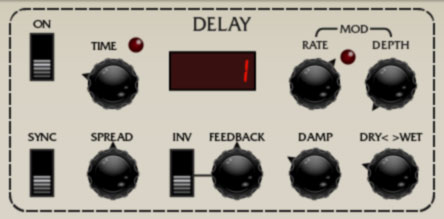
Eight Voice includes high-quality stereo modulation delay and reverb effects. With its built-in modulation, the delay is particularly flexible, capable echos, flanging and chorus effects.
Delay

On/Off- Enables and disables the delay effect.
Time knob / LED / digital display- Sets delay time, from 1 to 2000 ms. If the Sync button is enabled, time settings snap to synchronized note values (see Sync switch below). The LED beside it flashes at the current rate and the number display shows the exact time.
Sync- Enabling the Sync switch locks the delays time to master tempo. When engaged, the Time knob snaps to note values ranging from 1/64th note triplet to 8 beats. Sync mode locks to the tempo in the top toolbar when using the standalone version or the current project tempo when using the plug-in version in a DAW.
Spread- Simultaneously subtracts and adds up to 20ms of delay time to the left and right channels respectively, creating a wide stereo effect. It also prevents echoes from "piling" up in the center of the image. Note that the subtracted and added delay effectively changes the overall delay time setting with each repeat, so long delays combined with high feedback settings can become noticeably off time, so we recommend setting Spread to zero if you're using high feedback echoes with many in-time repeats.
Feedback / Invert switch- Routes the output to the input for additional repeats. The Inv switch flips the phase of the delay signal. You won't hear much difference between the Inv switch positions with standard repeating delays, but inverting the phase is noticeable with delay times in flanging range (15ms or less) and the feedback knob cranked (more on this in the Mod section below).
Mod Controls- These allow modulation of the delay time using the Delay section's internal sine-wave LFO (this is separate from LFO 1 and LFO 2). The addition of time mod enables flanging and chorus effects as well as wilder, swooping pitch effects at more extreme settings. Note that the digital time display doesn't change as modulation varies the time (if it did, the time display wouldn't be readable).
Rate knob and LED- Varies the speed of time modulation from 0.15 to 30 Hz. The LED flashes at the current mod rate.
Depth- Mod depth affects how much the time is varied by.
Creating Flanging and Chorus effects - The primary purpose of the Mod controls are to allow flanging and chorus effects. Flanging and chorus are closely related; the difference is that flanging typically creates metallic and/or jet flyby "whooshing" sounds, whereas chorusing produces a gentle, mildly detuned doubling effect.
To create a flange, set the Time to 15ms or less, Feedback over 70%, slow Mod/Rate, Mod/Depth over 60%, and Dry/Wet to 50%.
To create a chorus effect, set the Time around 20ms, Feedback at 0, Mod/Rate around 0.60 Hz, Mod/Depth 6% (this is actually center knob position), and Dry/Wet to 50%. Engage the Spread switch for a nice stereo chorus.
Damp- Attenuates high frequencies as the slider amount is increased. Not only does this create more natural sounding decays, it also reduces the "stacking" effect that occurs with high feedback levels.
Dry < > Wet- Balances the level of dry and wet signal. Setting the knob to the center position gives an equal 50/50 balance of wet and dry signal.
Reverb

On/Off- Enables and disables the reverb effect.
Decay- Sets the overall length of reverb; the actual time varies dependent on the reverb type.
Reverb Type - Hall/Room/Spring- Allows selection of three different types of reverb.
Damp- Attenuates high frequencies as the slider amount is increased for more natural reverb sounds.
Dry < > Wet- Balances the level of dry and wet signal.